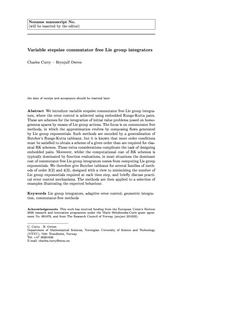| dc.contributor.author | Curry, Charles Henry Alexander | |
| dc.contributor.author | Owren, Brynjulf | |
| dc.date.accessioned | 2020-02-05T13:39:47Z | |
| dc.date.available | 2020-02-05T13:39:47Z | |
| dc.date.created | 2018-05-31T01:44:07Z | |
| dc.date.issued | 2019 | |
| dc.identifier.citation | Numerical Algorithms. 2019, 82 (4), 1359-1376. | nb_NO |
| dc.identifier.issn | 1017-1398 | |
| dc.identifier.uri | http://hdl.handle.net/11250/2639869 | |
| dc.description.abstract | We introduce variable step size commutator free Lie group integrators, where the error control is achieved using embedded Runge–Kutta pairs. These are schemes for the integration of initial value problems posed on homogeneous spaces by means of Lie group actions. The focus is on commutator free methods, in which the approximation evolves by composing flows generated by Lie group exponentials. Such methods are encoded by a generalization of Butcher’s Runge–Kutta tableaux, but it is known that more order conditions must be satisfied to obtain a scheme of a given order than are required for classical RK schemes. These extra considerations complicate the task of designing embedded pairs. Moreover, whilst the computational cost of RK schemes is typically dominated by function evaluations, in most situations, the dominant cost of commutator free Lie group integrators comes from computing Lie group exponentials. We therefore give Butcher tableaux for several families of methods of order 3(2) and 4(3), designed with a view to minimizing the number of Lie group exponentials required at each time step, and briefly discuss practical error control mechanisms. The methods are then applied to a selection of examples illustrating the expected behaviour. | nb_NO |
| dc.language.iso | eng | nb_NO |
| dc.publisher | Springer Verlag | nb_NO |
| dc.relation.uri | https://arxiv.org/abs/1804.02123 | |
| dc.title | Variable step size commutator free Lie group integrators | nb_NO |
| dc.type | Journal article | nb_NO |
| dc.type | Peer reviewed | nb_NO |
| dc.description.version | acceptedVersion | nb_NO |
| dc.subject.nsi | VDP::Matematikk: 410 | nb_NO |
| dc.subject.nsi | VDP::Mathematics: 410 | nb_NO |
| dc.source.pagenumber | 1359-1376 | nb_NO |
| dc.source.volume | 82 | nb_NO |
| dc.source.journal | Numerical Algorithms | nb_NO |
| dc.source.issue | 4 | nb_NO |
| dc.identifier.doi | https://doi.org/10.1007/s11075-019-00659-0 | |
| dc.identifier.cristin | 1587881 | |
| dc.relation.project | EC/H2020/CHiPS | nb_NO |
| dc.relation.project | Norges forskningsråd: 231632 | nb_NO |
| dc.relation.project | EC/H2020/CHIPS | nb_NO |
| dc.description.localcode | This is a post-peer-review, pre-copyedit version of an article. The final authenticated version is available online at: https://doi.org/10.1007/s11075-019-00659-0 | nb_NO |
| cristin.unitcode | 194,63,15,0 | |
| cristin.unitname | Institutt for matematiske fag | |
| cristin.ispublished | true | |
| cristin.fulltext | postprint | |
| cristin.qualitycode | 1 | |
